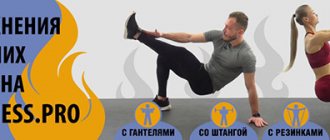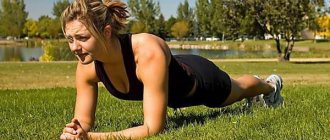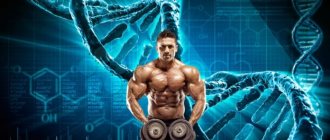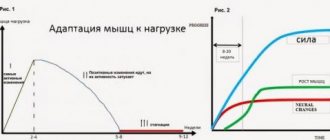Whether you are actively involved in sports or not, muscles grow and break down. For example, a physically healthy man renews about 100g per day. proteins. If you actively train, this process accelerates. It is possible and necessary to minimize muscle destruction, if only in order to achieve good results from exercise and an athletic physique as quickly as possible.
If it is almost impossible to influence the renewal process itself, then it is possible to reduce additional loss of muscle mass. Muscles will not be destroyed out of the blue beyond the normal norm, only under certain conditions, for example, due to stress, illness, lack of sleep, fasting, and physical fatigue.
Even if you get enough sleep, practice meditation to relieve stress, eat a healthy diet, and exercise enough, you can easily lose muscle mass for various reasons.
Is muscle destruction necessary during training or not?
The classical dialectics of strength training suggests that IN training we destroy the physiological structures of the muscle fiber (MF), the body “accepts” this stress and adapts to it.
During the rest period, AFTER training, the so-called supercompensation occurs and we come to the next training with increased potential, i.e. with muscle hypertrophy. Thus, it can be stated that, yes, according to this formulation of the question, muscle destruction is necessary.
However, the logic of the narrative can also be constructed by contradiction. Training, as such, involves stimulating the process of synthesis of muscle protein structures. For example, according to Seluyanov’s theory, this is the acidification of the cell through free Creatine (Cr) and hydrogen ions H+; according to the theory of signaling proteins, this is the activation of cell mechanisms such as mTor, Akt, E4-BP1, etc. There seems to be no need to destroy the structures of the cell itself. A shift in cell homeostasis towards acidification is required, which will provide the necessary stimulation of the cell for subsequent hypertrophy.
For Seluyanov, by the way, the destruction of the CF is generally an undesirable component, because, firstly, it increases the recovery time between training and does not make it possible to carry out these trainings more often, but they could increase the total volume of the incremented structures, and secondly, it reduces the general level of the constructed structures, because it is also necessary to build the destroyed components!
Why BCAA?
The most interesting thing in the confrontation between these two theories on hypertrophy seems to be their practical application and, in particular, whether or not to take certain types of sports nutrition supplements.
A thoughtful strength training practitioner will often ask a very reasonable question: “Okay, let’s say the theory of muscle fiber breakdown is true. BCAA amino acid supplements, as we know, counteract muscle catabolism. Then why should I drink BCAAs during training? They will interfere with the destruction of muscles and in the end I will not be able to build these muscles!”
Agree, the statement is quite logical! Logical, if you do not take into account that physiological muscle catabolism and the destruction of muscle fiber during strength training (mechanical) are essentially two different processes.
Eat vegetables and fruits
Your diet should definitely include fruits. Eat vegetables. They contain a large amount of fiber useful for digestion and minerals necessary for our body.
And regular consumption of fruits in large quantities fills your body with vitamins. Fruits and vegetables are high in fiber. Thanks to it, food is digested more slowly and calories are used as needed, so they are not stored as fat.
Attention! Consult your doctor or dietitian before taking any of the following steps.
To improve the quality of your workout, you should consume mixtures of carbohydrates and proteins upon completion. This mixture will help you recover faster and restore amino acids destroyed by heavy loads. Replace destroyed amino acids faster and you will experience less muscle catabolism.
Let's go into more detail.
The first process is physiological catabolism. All structural elements of the body (cells, proteins, organelles, etc.) have a life period, and can also lose their integrity as a result of any failures, therefore they must be renewed at a certain frequency. Old molecules, proteins, and cells are replaced by new ones. In order to “remove” the old structure, it must be destroyed, i.e. subject to catabolism.
In relation to muscle myofibrils, and they interest us to a greater extent since they constitute the bulk of our muscles (75-85%), the so-called process occurs. proteolysis (decomposition and digestion).
This process begins with the fact that a special signaling element called ubiquitin is attached to the myofibril, which ruptures the myofibril and attracts proteolytic enzymes into the resulting lumen, which, in an amino acid manner (or a group of amino acids - a peptide), begin to “split” this myofibril. This process is activated when the CF cell experiences a lack of energy. In particular, this condition will be provoked by heavy/long training. So, this variant of catabolism is undesirable for the process of muscle hypertrophy!
The most important point here will be the answer to our thoughtful athlete - BCAA amino acids will resist such catabolism. In particular, BCAAs reduce the level of these ubiquitins.
Taking BCAAs during training is not only possible, but also NECESSARY!
Now process number TWO - mechanical destruction of the muscle. How does it happen? The brain sends an electrochemical signal to the working muscle. The MV membrane changes potential. Ca+ ions enter the sarcoplasm from the sarcoplasmic reticulum (SRR), which activate ATPase. ATP, the energy currency of the cell, is hydrolyzed to ADP (adesine diphosphate) and phosphate. Those. Energy is released, through which the myosin bridge attaches to the actin filament and makes a traction movement - muscle contraction occurs. Then the cell membrane potential returns to normal, Ca+ ions leave the sarcoplasm - return to the SPR, ATP energy is renewed through Creatine phosphate, glycolysis or oxidative phosphorylation and the muscle is ready for a new “stroke” of myosin bridges.
And now, having a preliminary picture of the work of the MV, let’s imagine, and this is actually what happens, that the subsequent, next restoration of the ATP molecule does not occur! This does not happen due to either CF acidification or depletion of cell resources - glycogen and/or fatty acids. Then, of the entire volume involved in the contraction of muscle fibers, part is turned off. Let's imagine that out of 1000 motor units, 200 have become acidic and cannot renew ATP energy. But...the load continues! We still lift and lower the weight. Yes, it becomes a little more difficult to do this, you know how it happens, but no one gives up the approach right away, we continue to press or pull our barbell!
And now the most interesting point in this story: muscle fibers that cannot renew ATP energy begin to tear under the force of negative load. This happens because the myosin bridge can be detached from the actin filament ONLY in the presence of ATP energy. If there is no such energy, then it is associated with actin and no sliding of the filaments (actin and myosin) relative to each other occurs. It is not the “actins” and “myosins” themselves that are torn, but the integrity of the MV as a whole, as a unit, is disrupted. The weakest link is considered to be the so-called Z-discs, which change their configuration - they stretch. Due to the fact that they are connected to the outer shell of the muscle cell - the basement membrane, it is this outer part that suffers damage.
The most important point in the theory of hypertrophy through destruction is the fact that between the basement membrane and the inner cell membrane - the sarcolemma there are so-called. satellite cells. When the membrane ruptures, these cells enter the cell and can be profiled into any cellular structure. In particular, into myofibrils and/or muscle nuclei. This is one of the most important points why it is necessary to “DESTROY” a muscle during training!
Well, in conclusion, again an answer to our inquisitive athlete. NO additives can affect this type of destruction - mechanical destruction! This destruction is essentially the first stage of creation - that is, ANABOLISM!
Therefore, drinking BCAA amino acids during training is completely acceptable - the muscles will still “tear” during training. But in order to intensify the process of restoration and growth of new protein structures, it is rational to drink a complete “amino acid set” after training - yes, that’s right, a PROTEIN drink!
LIT-RA USED:
Causes of myositis
Myositis is caused by any condition that causes muscle inflammation. The causes of myositis can be divided into several categories:
Inflammatory diseases
This category includes all diseases characterized by an intense inflammatory process, which can also affect muscle tissue, leading to the development of myositis. Most of these conditions are autoimmune in nature. In autoimmune inflammation, the body begins to attack its own tissues. Inflammatory diseases that cause potentially serious myositis include:
- dermatomyositis;
- polymyositis;
- inclusion body myositis.
Other inflammatory diseases that cause milder forms of myositis include:
- systemic lupus erythematosus;
- scleroderma;
- rheumatoid arthritis.
Typically, inflammatory diseases cause the most serious forms of myositis, which require long-term treatment.
Infections
Most often, myositis is caused by various viral infections, less often by bacteria, fungi and other organisms. Viruses or bacteria can infect muscle tissue directly or produce substances that damage muscle fibers. Colds, flu and HIV can cause myositis, as can many other infections.
Medicinal substances
Many different medications can cause temporary muscle damage. Because muscle inflammation is often unidentified, the muscle problem is referred to as myopathy rather than myositis. Drugs that cause myositis or myopathy include:
- statins;
- colchicine;
- Plaquenil (hydroxychloroquine);
- alpha interferon.
Myopathies may appear immediately after starting treatment or occur after several months or years of taking the drug. Sometimes myopathy is caused by an interaction between two different medications. Severe myositis is rarely associated with medications.
Injuries
Vigorous exercise can lead to muscle pain, swelling, and weakness for many hours or days after exercise. The presence of inflammation allows this form of pain to be formally classified as myositis; in fact, in this case the person experiences muscle pain (myalgia). Symptoms of myalgia after exercise or injury almost always go away on their own with rest and recovery.
Acute skeletal muscle necrosis (rhabdomyolysis)
Acute skeletal muscle necrosis is an extreme degree of myopathy in which muscle destruction occurs. Muscle pain, weakness and swelling are symptoms of radbomyolysis. In some cases, the urine of such a patient becomes dark brown or red in color.
How to protect muscles from destruction?
It is known from physiology textbooks that in the body of a healthy man who does not engage in sports, up to 100 g of proteins are renewed per day. So, whether you exercise or not, muscles are still constantly being broken down and grown. Naturally, in athletes these processes are more active. If you try to minimize muscle breakdown and create ideal conditions for their growth, you have a chance to get a beautiful, athletic figure.
It is impossible to influence the normal process of muscle protein renewal, but you can try to avoid additional loss of muscle mass. As you understand, muscles do not simply break down beyond normal limits; this requires certain conditions, namely a stressful state. This could be fasting, lack of sleep, physical activity, nervous strain, or illness.
As soon as stress occurs, catabolic hormones are released such as cortisol, glucagon, adrenaline, etc. Their task is to provide the body with energy, even at the cost of destroying muscle tissue. It's better to eat a small part of yourself than to be completely eaten by your enemy!
You can easily sleep a lot, eat well, and not be nervous, but you cannot avoid active training. Just during strength training, you can lose up to several hundred grams of muscle mass! Next, let's look at why this might happen.
When you begin strength training, your body takes energy from muscle glycogen (carbohydrates). This is very convenient, because the fuel is in the muscles themselves. 100 g of muscle can hold up to 2 g of glycogen, and in professional athletes even up to 4 g. If multiplied by the entire body weight, you get 1000-1500 g of glycogen and another 100-150 g in the liver. It turns out 4400-6600 calories. Why do you need to convert to calories? Read on!
Weight training (bodybuilding) is far from the most energy-intensive form of physical activity. An athlete weighing 80 kg will spend about 500 calories in 1 hour. For comparison, while walking at a brisk pace (7 km/h) he would have to burn about 650 calories.
Should we worry about where to get a measly 500 calories from if we only have 6,000 calories worth of glycogen?
Glycogen is not stored in muscles as reliably as thigh fat. It is constantly being used up and replenished. If you feel hungry, consider that there is almost no “extra” glycogen. In this state, the body will very quickly begin to burn muscle for energy.
Glycogen is stored evenly in all muscles. If you pump your biceps, it uses up its own glycogen and will not be able to take reserves from your legs. You can’t count on liver glycogen either, because it is intended primarily to nourish the brain.
Another interesting point is that the body will not wait for the moment when you completely use up all the glycogen and fold your arms from a loss of strength. Shortly after starting a workout, cortisol levels rise, and it has a simple job - just in case, it destroys muscle.
The less glycogen you have and the more intense the workout, the greater the cortisol release. Notice that after 60 minutes of training, cortisol begins to rise again.
100 g of muscle contains about 20 g of protein (80 calories). Thus, if during training you do not have enough calories from glycogen, you will have to part with 20 g of muscle.
How to protect muscles from destruction during training?
1. Load up on complex carbohydrates 1-2 hours before training and in previous meals. This way you will have maximum glycogen. 2. Reduce training time to 45-60 minutes. If this is not enough for you, add 1 more workout per week. 3. Before training, take a portion of BCAA according to the instructions on the package. 4. Use additional cortisol blocking supplements (eg HMB). 5. Drink sweet water during training. This point is very controversial. You are unlikely to be able to drink water in which 50 g of sugar (10 teaspoons) is dissolved. It is not a fact that the body will have time to deliver this sugar to the muscles during training. However, there will be some positive effect from simple carbohydrates, because taking sugar will cause the release of insulin, a powerful anti-catabolic hormone.
Should you worry about muscle breakdown during training?
You decide. But even 50g of muscle mass that can be preserved turns into 500g in 10 workouts, and into 5 kg in 1 year.
And finally
How critical is it to drink gainer, amino acids or protein immediately after training? Many people, without having time to catch their breath properly, grab the shaker. It looks very funny. The training ended, and with it the stress ended. Calorie consumption becomes minimal. If catabolism actively continued, after training there would be no feeling of hunger, but there is hunger, and strong. Your body is waiting for feeding. Maximum muscle destruction occurred during training. Now you can calmly change clothes, take a shower and then eat something. Whether it's a gainer or a couple of bananas, it doesn't matter. Much more important is the fact of calorie intake. Muscle recovery takes 48-72 hours, and it is foolish to hope that your progress depends on your post-workout meal. This meal is just as important as the next 15!
Muscle catabolism. Why does it destroy muscles? How to reduce its speed?
Muscle catabolism. Why does it destroy muscles and why does the body need it? Mechanism of action. Reasons affecting the rate of catabolism. How can you slow down this process? What should you remember when interfering with the body's metabolic processes?
Everyone understands that exercise in the gym is needed not only for weight loss, but also for acquiring beautiful muscle forms. But sometimes you can spend a lot of effort in training, but there will be no results.
Many chemical reactions and processes occur in the body. Metabolism is the totality of all metabolic processes in the body. Processes aimed at cell growth are called anabolism; they create tissue (including muscles) from simple components. The opposite of anabolism is catabolism, that is, processes aimed at breaking down complex elements to produce energy. All these processes occur constantly and simultaneously. Muscle growth is achieved when the rate of anabolic processes is higher than the rate of catabolism.
Treatment
Treatment depends on the cause of the pathology. Non-steroidal drugs (local, tablet or injectable) are often prescribed, which eliminate inflammatory processes and anesthetize tissues.
For infectious diseases, antiviral, antiparasitic or antibacterial drugs are used. In the autoimmune form, drugs that suppress the immune system (glucocorticosteroids or cytostatics) are used. To strengthen the defenses, complexes of vitamins and minerals are prescribed.
Non-drug therapy plays a special role in treatment. This includes:
- massage (there are contraindications);
- physiotherapy;
- physiotherapy (electrophoresis, magnetotherapy, amplipulse therapy).
Muscle catabolism
Are there obvious signs of catabolism? Yes, I have. Obvious signs are that, despite intense training, muscle mass not only does not grow, but may even decrease, and the fat layer in certain places (on the abdomen) remains and increases.
Nettle for hair. Stops hair loss and improves hair health →
By and large, with any sport that results in an increase in loads, pronounced manifestations of catabolism cannot be avoided. First, the body draws energy from food, then fat deposits are consumed, but when they run out, it is the turn of muscles. Muscles are great for this purpose if there are no other sources of energy.
In principle, any muscle drying is catabolism, since fat tissue cells are destroyed. That is, this process is not negative, it is a normal metabolism that occurs constantly in the body of any person. But those who strive to build muscle mass and train intensely should reduce the speed of this process from a certain period. This must be done very carefully, understanding the mechanisms of reactions occurring in the body.
The body's response to stress during exercise is the production of hormones, the purpose of which is to alleviate stress for the body. Immediately after the end of an intense workout, a period begins that athletes call the “carbohydrate window.” This is a period when the level of hormones produced during training (adrenaline, cortisol) is still high, and they continue to work, and there is no longer a need to release energy by breaking down proteins, fats, and glycogen. Thus, after the end of the load, the launched mechanism of catabolism already harms the muscles, destroying them. This period lasts about half an hour.
The stronger the training load, the more energy is consumed, and the less glucose remains in the blood. And this causes the release of more cortisol, as it is designed to increase glucose levels by extracting it from amino acids in muscle tissue. During intense training, as a result of catabolism, the athlete loses up to 200 g of muscle.
By supplying glucose to the body during exercise, for example through cocktails, cortisol levels are reduced. And this reduces the breakdown of muscle tissue after training. In addition, as the concentration of glucose in the blood increases, the level of insulin increases. And it smoothes out the negative effects of cortisol.
Myasthenia gravis
A disease of the autoimmune system that causes muscle weakness due to interruptions in neuromuscular transmission is called myasthenia gravis. The activity of the ocular, facial and masticatory muscles is usually impaired; the muscles of the respiratory organs are less commonly affected. Characteristic manifestations: drooping of the lower eyelid, disturbances in vocal function (nasal sound, hoarseness, hoarseness or weakness), disturbances in swallowing and chewing.
The word "myasthenia" means impotence, muscle weakness. This is a pathological process, which is based on the self-destruction of body cells. The normal immune response changes direction and begins to destroy its own cells instead of foreign ones, which leads to the destruction of organs and tissues of the body.
Possible reasons:
- genetic predisposition;
- benign or malignant tumors;
- systemic diseases;
- damage to the nervous system;
- hyperthyroidism, sleeping sickness.
How to reduce the rate of catabolism
To successfully build muscle, you need to avoid stress as much as possible, drink a lot, and avoid lack of sleep. Lead a healthy, active lifestyle. If necessary, you need to take vitamins and medications that enhance immunity.
Nutrition is very important. Of course, the most important element of an athlete’s nutrition is protein, the building material for muscles. But carbohydrates and fats cannot be completely excluded. Without enough fat, muscles will not form either. A complete refusal of carbohydrates will lead to exhaustion. Complex carbohydrates are a valuable source of energy. If you consume them 2 hours before training, the glycogen reserves in the muscles will increase, and this will reduce the rate of catabolism.
You can limit your workout time to one hour, which will avoid releasing cortisol again.
If you provide the body with nutrients during the “carbohydrate window” after training, the muscles will not suffer and catabolism will slow down. But this must be done immediately. These can be special cocktails that can be used during and after training.
There are also many sports nutrition supplements that specifically block cortisol. But their use should be competent and only after consultation with a doctor.
Diagnostics
Diagnosis of diseases can only be carried out by a doctor at a medical center. It begins with a detailed questioning of the patient: the nature of the pain, its intensity, location, and factors that intensify it are clarified. The doctor palpates (feels) the affected muscles, noting increased sensations, tightness, and the presence of swelling. Then it is assigned:
- collection of blood tests (general and biochemistry), urine;
- electromyogram, ultrasound, CT, radiography, MRI;
- If necessary, the doctor may prescribe an ECG and muscle tissue biopsy.
Contacting a qualified specialist will help protect yourself from making an incorrect diagnosis, since the pain that appears can be indistinguishable from other diseases. For example, pain in the lumbar region with myositis may be indistinguishable from kidney disease or similar to a vertebral hernia or osteochondrosis. An advanced disease will be very difficult to cure.
Warning
Rough interference in metabolic processes, in order to stop the destruction of muscles by catabolic processes, can severely damage the cardiovascular system, disrupt metabolism without the possibility of recovery, lead to infertility, and the occurrence of diseases. It is necessary to adequately assess the condition of the body and the possibility of such correction without damage. The consequences of invading body processes can be much stronger and more destructive than it might seem.
It is important not to bring the body to overtraining, when the balance between training and recovery is disturbed. If this happens, the result of training will not be sculpted muscles, but stress, injury and inflammation.
All that is needed to obtain a beautiful relief on the body is to reduce muscle destruction to a minimum and create all the conditions for their growth. This is possible, but you need to know and understand what processes take place in the body both during and outside of training.
Myalgia
Pathology of muscle tissue, accompanied by acute or dull spastic pain, both in a tense state and at rest, is called myalgia. Soreness can be of different origin and intensity, it can intensify and subside. It usually occurs due to an inflammatory process in the fibers.
Myalgia - symptoms and treatment
The disease can occur as a result of foreign factors, the effects of which the body itself cannot overcome:
1. External causes - high or low temperature, strong pressure on muscles, bacteria, fungi and viruses, ultraviolet radiation, exposure to heavy metal salts or acids.
2. Internal causes - complications of diseases of internal organs.
Myalgia
is a disorder that affects not only older people, but also children. Only a doctor can diagnose and determine individual therapy. If you do not consult a specialist in a timely manner and the disease develops, then from an acute form it can become chronic (permanent).
What destroys muscles?
What is cortisol?
Cortisol is the main catabolic hormone. Increasing its level leads to the destruction of muscles into amino acids that can be absorbed by the body, and glycogen (the main nutrient for muscles) into glucose, again for quick energy production.
It is important that increased cortisol levels lead to increased accumulation of subcutaneous fat, increases appetite (due to increased blood glucose levels), and also causes an increase in blood pressure.
Exercise and cortisol levels
Cortisol is produced in response to stress, fatigue, exercise, fasting, fear and other emergency situations. For comparison: normal cortisol levels are 10 g/dL, with a cold – 40 g/dL, with stress – 80 g/dL, with severe shock – 180 g/dL.
If we talk about physical activity, then in the first minutes of exercise the natural level of cortisol rises to 63 g/dl, then it drops to 35 g/dl at about 45 minutes, and again begins to rise sharply (see graph*, top line).
How to lower cortisol levels?
It was found that if during the workout itself you consume 5-10 g of BCAAs (the three most important amino acids for us), mixed with 20-30 g of simple carbohydrates (calculation for a person weighing 75 kg), then the level of cortisol is significantly reduced (see. graph, bottom line).
This can easily be explained by the fact that the hormone cortisol is produced to urgently provide the body with energy, and if a person already receives important amino acids and glucose, then his body simply does not need to make excessive sacrifices.
Optimal training duration
As you can see from the graph, after 45 minutes of training (without supplements in the form of BCAAs and glucose), cortisol levels rise sharply - this means that after this time the body begins to eat its own muscles for energy.
Actually, this is where the recommendation comes from to exercise no more than 45-60 minutes. But the good news is that when you take a supplement, you lower your cortisol levels and your workout can be longer and more effective.
Why does BCAA help?
BCAAs are the three most important amino acids that cannot be synthesized in the body on their own (leucine, isoleucine, valine). Moreover, leucine is critical for muscle growth, and with its deficiency, muscles simply do not grow.
By taking BCAAs in the first half of your workout, you provide your muscles with a significant supply of leucine. And the above-mentioned 20-30 g of simple carbohydrates (you can use regular sugar) are important for the body for the rapid synthesis of energy.
***
During exercise, the stress hormone cortisol is produced, which destroys muscles. Maximum production occurs 45-60 minutes after the start of training. Using supplements can stop this process.
Symptoms of the disease
A disease of the autoimmune system that causes muscle weakness due to interruptions in neuromuscular transmission is called myasthenia gravis. The activity of the ocular, facial and masticatory muscles is usually impaired; the muscles of the respiratory organs are less commonly affected. Characteristic manifestations: drooping of the lower eyelid, disturbances in vocal function (nasal sound, hoarseness, hoarseness or weakness), disturbances in swallowing and chewing.
The word "myasthenia" means impotence, muscle weakness. This is a pathological process, which is based on the self-destruction of body cells. The normal immune response changes direction and begins to destroy its own cells instead of foreign ones, which leads to the destruction of organs and tissues of the body.
Possible reasons:
- genetic predisposition;
- benign or malignant tumors;
- systemic diseases;
- damage to the nervous system;
- hyperthyroidism, sleeping sickness.
Cortisol: the whole truth about the stress hormone
My respect, dear readers! Quite often in our articles we talked about muscle growth factors and nutrition for building them, but we hardly mentioned a word about anchors, which can negate your entire training process. We will talk about one such anchor today, and its name is the hormone cortisol. Almost all bodybuilders fear it like fire and consider it truly enemy number one in the matter of muscle anabolism. Whether this is true or not, we have to figure it out in this note.
So, take your seats, we're starting.
Symptoms of the disease
Muscle tissue diseases are disorders of the working condition of an individual muscle or an entire group caused by various reasons and locations. As a rule, muscle tissue diseases have common symptoms:
- sharp or dull (aching) pain in the disease area (neck, shoulder girdle, lower back and others);
- increased pain when pressing, leaving a state of rest (when getting up in the morning), physical activity;
- redness and swelling of the skin in the area of the disease;
- detection of swelling or nodules in the muscles;
- muscle weakness, which is accompanied by dystrophy (shrinkage);
- pain and difficulty in performing simple everyday movements (turning the head, nodding, bending the body).
The hormone cortisol: chemistry and biology and its role in gaining muscle mass
You should already have a pretty good understanding of hormones, because we have already looked at such ones as somatotropin and testosterone. Cortisol stands apart from these hormones, since its actions can hardly be considered creative; rather, on the contrary, it has a more destructive side.
Many bodybuilders are afraid of this “destroyer”. Yes, indeed, it’s very difficult to call this hormone a friend, but I certainly don’t dare call it an enemy. Why? Let's find out further.
Now I may be destroying the idea of many people about how to acquire big muscles and a sculpted body. In all the textbooks we are told that we need to train technically, eat right and recover well - this is really so, let’s exhale :). However, I would also add to these postulates the ability to manipulate (skillfully manage) your hormonal levels, i.e. secretion of anabolic and catabolic hormones.
Any athlete (regardless of whether he is a bodybuilder or a fitness specialist) should try with all his might to suppress and stop the body’s attempts to destroy muscle mass. In particular, it is necessary to constantly monitor and keep a tight rein on the secretion of a hormone such as cortisol.
The hormone cortisol - what is it?
Cortisol is a glucocorticoid disruptor hormone that is secreted by the adrenal cortex in response to physical/emotional stress (fatigue). The task of cortisol is to have a “calming” effect on the body in the event of a stressful situation, i.e. force him to suppress the immune response and stop reacting “painfully” to the problem.
Hormone cortisol: effects
Effects of cortisol:
- increased breakdown of proteins/fats/carbohydrates;
- interference in the processes of construction of protein structures;
- increased cellular metabolism;
- muscle pain;
- overtraining syndrome;
- strengthening the synthesizing function of the liver;
- vasoconstriction;
- increased blood pressure;
- anti-inflammatory effect.
In the process of increasing the secretion of this hormone, protein synthesis sharply decreases. This metabolic shift occurs as the body searches for an alternative fuel source. And cortisol is designed to solve this problem.
During intense exercise or periods of fasting (malnutrition), blood glucose levels decrease. The destroyer hormone wastes no time and begins to actively trigger the process of muscle fiber breakdown. As a result, amino acids from muscles can be used for the synthesis of glucose molecules in the process of gluconeogenesis (synthesis of glucose from non-carbohydrate residues). In general, the hormone is designed to mobilize the simplest nutrients: it receives amino acids as a result of the breakdown of proteins, and receives glucose from glycogen.
The body is a thinking and self-regulating system, so once it has experienced stress, it increases the level of glucose and amino acids in order to provide itself (in the future) with building material for recovery. When the human body is “under stress,” it cannot afford to waste energy, therefore, by triggering the breakdown of protein, cortisol simultaneously stops its synthesis. After all, you must admit that breaking and then building is nonsense.
Let's take a closer look at the mechanisms of cortisol production.
Hormone cortisol: mechanisms of production
In the body everything starts from the head, i.e. with the central nervous system. Reacting to external influences (stress, loads, etc.), the “skull” sends nerve impulses to the hypothalamus. The response is the secretion of a special hormone, which is transported with the blood to the pituitary gland. All this stimulates the release of corticotropin (ACTH hormone). The latter, once in the general bloodstream and adrenal glands, causes the secretion of cortisol by the adrenal cortex (see image).
This destructive hormone reaches liver cells, penetrates their cytoplasm and establishes a connection with special proteins. They are responsible for feedback – the body’s reaction to cortisol and the external causes that caused it.
The response is:
- increased glucose synthesis in the liver;
- slowing down the breakdown of glucose;
- synthesis of proteins in tissues (including muscle).
From all of the above we can draw a simple conclusion. As a result of stress, the body tries to save available energy resources (reduce their consumption by muscle tissue) and replenish what is lost (the glycogen depot in the liver can be easily used as an easily mobilized source of energy).
Note:
The body of a healthy man produces up to 25 mg of cortisol per day; as a result of stress, this figure can reach 250 mg. 90 minutes is the time it takes to remove 1/2 of the initial amount of cortisol from the body.
Phew, we're done with biochemistry, let's move on.
The hormone cortisol and exercise: muscle breakdown
Why does cortisol destroy muscles? Quite an interesting question, if you don’t go into chemical details, then in a nutshell this process can be described as follows.
When the level of cortisol in the muscles increases, the mechanism of tissue destruction is triggered, i.e. muscle cells break down into simple components (amino acids and glucose) that can be absorbed by the body. As a result of stress, blood pressure increases and this speeds up the flow of large amounts of free glucose (produced from breakdown) into the brain. All these processes ultimately cause “adrenaline shock” - a sudden, sharp surge of energy, and the body experiences enormous stress.
Many of you who have read this far have probably already disliked cortisol. However, here it is worth understanding that although this hormone is a trigger for the massive destruction of muscle cells, it is its excess in the blood or its constant deficiency that is dangerous for the bodybuilder’s body.
For example, a constantly high concentration of this hormone leads to causeless stress, increased irritability and metabolic disorders. The latter, most often, manifests itself in the form of obesity or increased fat deposition in problem areas of a person (men - stomach, lower back; women - thighs).
Note:
Excess stress hormone most often occurs due to persistent athlete overtraining syndrome.
In turn, a lack of cortisol in the body will lead to the inability to train effectively. Because it has a strong anti-inflammatory effect and greatly promotes muscle relaxation after physical activity. If there is not enough cortisol in the blood, your muscles will experience serious inflammation and pain after working with weights (numerous micro-tears and injuries).
Thus, we can conclude that there must be a golden mean in everything.
It will be useful to know that in the first minutes of physical activity, the level of stress hormone increases to 60-65 units, then decreases to about 30. After 50 minutes of training, its level begins to rise again.
Now let's talk about the training itself.
Hormone cortisol: training
From the graph above we can conclude that the ideal time for training is a period of 45-50 minutes. Outside this time zone, cortisol levels rise and the body starts destruction processes.
Keep this in mind when creating your training program.
Stubborn statistics say that 9 out of 10 amateur athletes have elevated levels of the stress hormone. If you dig deeper, you can understand that there is nothing surprising in this. After all, usually “worldly” people come to the gym, which means everyone has their own personal problems, stressful work (monster boss), studies (flunked session), etc.
All these are far from ideal conditions for training. It is this combination that gives rise to low performance among amateur beginners.
Note:
You must either completely isolate yourself from the outside world at least for the period while you are in the hall. Or give up everything and surrender only to the hands of bodybuilding, as bodybuilders of the golden age did, in particular Arnold. Did you know that a week before the start of the Mr. Olympia tournament, the terminator’s father died. He was asked if he could come to see him off on his last journey. He calmly replied: “no, I can’t do that, I have a tournament.” Arnie understood that such stress would not allow him to win and made a decision that seems blasphemous to us.
If you like intense strength training and are afraid that this kind of training will negatively affect your results, don’t worry. Yes, the level of cortisol after it can increase by 50%, but this is not the ultimate truth, because the mechanism and profiles of its secretion are very complex and do not fit into theory and numbers.
The level of cortisol constantly changes throughout the day, so its increased secretion as a result of external factors (heavy loads, etc.) is an indicator of the stability and accuracy of the athlete’s endocrine system. A timely reaction (in the form of a sharp increase in cortisol concentration after exercise) of the body is a completely normal reaction of the body.
When trying to get 6-pack abs, many blame cortisol for the accumulation of belly fat in the belly area. In fact, the stress hormone affects the amount of visceral fat (surrounding the internal organs), not subcutaneous fat. Therefore, if you don’t see any cubes, then it’s time to learn how to run correctly.
Let's move on and now we'll look at...
The hormone cortisol: methods for reducing it
We have already realized that under the influence of stress, hormonal levels change. But we will find out how it changes and what effect nutrition has on this change.
Immediately after training, many people like to replenish their reserves: water (1, placebo), carbohydrates (2), amino acids (3) and carbohydrates + amino acids (4). The results between short-term (immediately after exercise) and long-term effects (after 3 months) on changes in hormone secretion are presented below.
The graph shows that the percentage of fat loss is approximately the same for everyone. Group 4 achieved the greatest increase in muscle mass. The change in the level of cortisol secretion is clearly demonstrated in the following image.
Cortisol levels increased by more than 50% after training (placebo group). And the “amino acids” group remained unchanged. Carbohydrates received as part of a post-workout drink reduced the secretion of stress hormones (groups 2 and 4). By taking carbohydrates (glucose from a sports drink), the body does not need to create sugar itself, so cortisol levels do not increase.
Analyze the graphs and draw your own conclusions about what is best for you to consume after training. However, remember, over time, the muscles get used to the load and respond to them with less and less cortisol release, even without sports nutrition.
Note:
Human muscles contain more cortisol receptors, so when the body stops exercising, muscle breakdown occurs at an accelerated rate. Conclusion - train hard, intensely, with the right technique (without cheating) and not very often. The exercise should work muscles, not tendons.
Hormone cortisol: tips for reducing
Well, we’ve come to dessert, namely, recommendations that will help you reduce (or at least control at the proper level) the concentration of cortisol in the body. So, write down:
Tip #1.
In order not to succumb to the catabolic effect of cortisol, it is necessary to reduce the secretion of this hormone and at the same time increase the production of the opposite - anabolic ones. Shift the overall balance towards protein synthesis carried out by anabolic hormones - testosterone, growth hormone, insulin, iGF-1. Boost secretions naturally through foods and supplements.
Tip #2.
Increase the calorie content of your daily diet and increase the protein content in your diet (from 2 to 2.5 g). Try to keep the ratio of Omega-3 and Omega-6 fats to 1:1 (i.e. equal shares).
Tip #3.
Branched chain amino acids (leucine, isoleucine and valine). If you are familiar with sports nutrition, then include 5-10 g of BCAAs in your diet. Mix them with simple carbohydrates (30 g) and consume them in liquid form directly during training.
Tip #4.
Consume vitamin C (1-2 g) and garlic before training. Let the whole audience “smell” that today you have decided to lower your cortisol level using your own means :).
Tip #5.
Go to the pharmacy and buy rosea radiolla extract - a tonic that increases your resistance to adverse external influences.
Tip #6.
Pay enough attention to rest and recovery. Get at least 8 hours of sleep. Visit various relaxing treatments: spa, cedar barrel, massage, etc.
Tip #7.
Say no to overtraining. Training no more than 45-60 minutes.
Tip #8.
Don't sweat the small stuff and try to avoid stressful situations/people. Thumbs up and smile from ear to ear!
Well, dessert has been eaten, let's sum it up.
Afterword
Today we devoted an entire article to such a hormone as cortisol. The main conclusion you must draw is that the hormone is not as scary as it is made out to be. Of course, you need to fight its catabolic activity, but you shouldn’t overdo it and spend too much time on it. The body itself will tell you what to do and when, your task is not to sleep through these signals.
That's all, I was glad to write for you. Until we meet again, come back often, you are always welcome here!
What destroys muscles?
Additional entries:
- How many muscles does a person have? Muscles work at the will of a person. One of the zones is involved in the absorption of water and mineral salts...
- Muscles during swimming Everyone talks about the benefits of swimming, but most often this is just abstract talk. In this material…
- Abdominal muscles How to train the transverse abdominis muscle - the best exercises Hey guys! Today on our agenda is technical...
- Recovery after a workout How to recover faster after a workout: 10 reliable ways The main mistake of beginners and people who dream in short…










